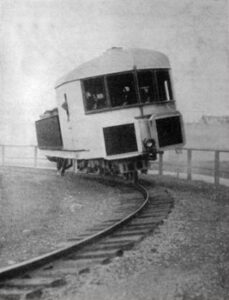Miguel Valdez and Matt Cook and I have been asked to write an article for The Conversation on ‘The Future of Public Transport’ and I am grappling with the draft text at this very moment. It’s not that we haven’t been doing very relevant research on the design of transport systems and their implications, but something as deterministic as ‘The future of….’ Is not really our thing.
Futurology is littered with predictions that simply fail to materialise. Have a look at the photo above of a lovely example of an impressively futuristic technology. It’s a gyroscopically stabilised monorail train that was actually built and proved to work. Yet this photo dates from 1911- well over a century ago – when, for a while, engineering writers were looking to a future of us all whizzing around the country on such technical marvels. Of course, it never happened; other new technologies were emerging at the same time, in particular the motor bus which easily outcompeted the gyro monorail.
Yet today we are living at a time when, for the first time in over 100 years, new forms of public transport are starting to emerge. If someone from 100 years ago were to travel, Tardis-like, to the present time they would broadly recognise our public transport systems – trains, trams, metros, tubes and buses were all around then and (albeit technically a bit different) are the mainstay of public transport today. The systems they operate are essentially identical, with services running on fixed routes to timetables and people obtain access by going to stops and buying tickets.
But what is starting to happen is that this long-term embedded systems design is starting to change. It started in ticketing, with cashless electronic ticketing and information systems such as timetable and trip planning apps. Earlier innovations, such as payment smart cards, are giving way to more flexible generic payment systems. Thus, the London Oyster Card is being replaced by advanced credit card software meaning an ordinary credit card acts like an Oyster Card for travel in London. But a more important step is now starting to emerge. This is when, rather than having digital add-ons for existing public transport services, the public transport service itself is redesigned around the capabilities of new smart technologies. The first driverless bus service started this month in Fife, running across the Forth Bridge to the edge of Edinburgh. As I reported in an earlier Blog here, the Chinese have developed a trackless electric tram and such a design concept is being emulated in Britain, France and other countries.
But all these technical designs are within the same systems design of fixed routes and timetables of traditional public transport. That is starting to be challenged by much more personalised and radical service designs, such as the Milton Keynes Connect service, whereby small vehicles are used, booked just like a taxi using an adapted cab booking app and software, that take people when and where they want to go within a city service area. No fixed routes; no timetables.
Then add in autonomous driving that is coming along and there is a potentially transformative shift to a form of public transport that, rather than people needing to adjust their behaviour to the schedules and routes of a bus or metro, they can travel directly, whenever they want, on services that can operate 24 hours a day, 7 days a week.
Will this happen? I really don’t know. There is a well-known design phenomenon when a technical breakthrough leads to a time of design diversity and a series of variations and permutations of that technology vie with each other before a winner emerges. With public transport we are now entering a time when a variety of both technology and service design permutations are starting to vie with each other. Which of these will end up as the gyro monorail dud and which will really be the public transport of the future is now up for grabs. And I for one am not going to lay bets on that outcome!


Leave a Reply